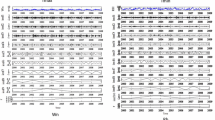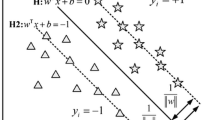Abstract
Parameter optimization is an important step for support vector regression (SVR), since its prediction performance greatly depends on values of the related parameters. To solve the shortcomings of traditional grid search algorithms such as too many invalid search ranges and sensitivity to search step, an improved grid search algorithm is proposed to optimize SVR for prediction. The improved grid search (IGS) algorithm is used to optimize the penalty parameter and kernel function parameter of SVR by automatically changing the search range and step for several times, and then SVR is trained for the optimal solution. The available of the method is proved by predicting the values of soil and plant analyzer development (SPAD) in rice leaves. To predict SPAD values more quickly and accurately, some dimension reduction methods such as stepwise multiple linear regressions (SMLR) and principal component analysis (PCA) are processed the training data, and the results show that the nonlinear fitting and prediction performance of accuracy of SMLR-IGS-SVR and PCA-IGS-SVR are better than those of IGS-SVR.











Similar content being viewed by others
References
Bao W, Yu G, Hu G et al (2017) Image matching algorithm based on Mahalanobis-Distance spectral features. J South China Univ Technol 45(10):114–120
Bergen A (2003) Random sampling: its effect on spectral density. Ire Trans Autom Control 4(3):198–198
Blackburn G (1998) Quantifying chlorophylls and caroteniods at leaf and canopy scale: an evaluation of some hyperspectral approaches. Remote Sens Environ 66(3):273–285
Broge NH, Leblanc E (2001) Comparing prediction power and stability of broadband and hyperspectral vegetation indices for estimation of green leaf area index and canopy chlorophyll density. Remote Sens Environ 76(2):156–172
Chen Y, Xu P, Chu Y et al (2017) Short-term electrical load forecasting using the support vector regression (SVR) model to calculate the demand response baseline for office buildings. Appl Energy 195:659–670
Cheng L, Zhu X, Gao L et al (2017) Estimation of chlorophyll content in apple leaves based on RGB model using digital camera. Acta Horticult Sin 44(2):381–390
Claeys D, Verstraelen T, Pauwels E et al (2010) Conformational sampling of macrocyclic alkenes using a Kennard-Stone-based algorithm. J Phys Chem A 114(25):6879–6887
Ding S, Qi B, Tan H (2011) An overview on theory and algorithm of support vector machines. J Univ Electron Sci Technol China 40(1):2–10
Ding X, Liu F, Zhang C et al (2015) Prediction of SPAD value in oilseed rape leaves using hyperspectral imaging technique. Spectrosc Spectral Anal 35(2):486–491
Fayed H, Atiya A (2019) Speed up grid-search for parameter selection of support vector machines. Appl Soft Comput 80:202–210
Gamon J, Peñuelas J, Field C (1992) A narrow-waveband spectral index that tracks diurnal changes in photosynthetic efficiency. Remote Sens Environ 41(1):35–44
Gao X, Hou J (2016) An improved SVM integrated GS-PCA fault diagnosis approach of Tennessee Eastman process. Neurocomputing 174(JAN.22PT.B):906–911
Gitelson A, Kaufman Y, Merzlyak M (1996) Use of a green channel in remote sensing of global vegetation from EOS-MODIS. Remote Sens Environ 58(3):289–298
Hasanipanah M, Shahnazar A, Amnieh H et al (2016) Prediction of air-overpressure caused by mine blasting using a new hybrid PSO-SVR model. Eng Comput 33(1):23–31
Hui G, Sun L, Wang J et al (2016) Research on the pre-processing methods of wheat hardness prediction model based on visible-near infrared spectroscopy. Spectrosc Spectral Anal 36(7):2111–2116
Jia L, Fan M, Zhang F et al (2009) Nitrogen status diagnosis of rice by using a digital camera. Spectrosc Spectral Anal 29(8):2176–2179
Li Z, Hu D, Zhao DZ et al (2015) Research advance of broadband vegetation index using remotely sensed images. J Yangtze River Sci Res Inst 32(1):125–130
Li M, Li J, Mao H (2016a) Tomatoes phosphorus nutrition diagnosis based on spectral and physiological characteristics. Trans Chin Soc Agric Mach 47(03):286–291
Li Y, Chang Q, Liu X et al (2016b) Estimation of maize leaf SPAD value based on hyperspectrum and BP neural network. Trans Chin Soc Agric Eng 32(16):135–142
Li Z, Zhang F, Chen L et al (2018) Research on spectrum variance of vegetation leaves and estimation model for leaf chlorophyll content based on the spectral index. Spectrosc Spectral Anal 38(05):211–217
Lichtenthaler H (1987) Chlorophylls and carotenoids: pigments of photosynthetic biomembranes. Methods Enzymol 148C(1):350–382
Lichtenthaler H, Gitelson A, Lang M (1996) Non-destructive determination of chlorophyll content of leaves of a green and an aurea mutant of tobacco by reflectance measurements. J Plant Physiol 148(148):483–493
Liu H, Chen H, Min S et al (2017) Tensile strength prediction for plant fiber mulch based on PSO-SVR. Trans Chin Soc Agric Mach 48(4):118–124
Ma X, Feng J, Guan H et al (2018) Prediction of chlorophyll content in different light areas of apple tree canopies based on the color characteristics of 3D reconstruction. Remote Sens 10(3):429
Merzlyak M, Gitelson A, Chivkunova O et al (2010) Non-destructive optical detection of pigment changes during leaf senescence and fruit ripening. Physiol Plant 106(1):135–141
Odabas M, Simsek H, Lee C et al (2016) Multilayer perceptron neural network approach to estimate chlorophyll concentration index of lettuce (Lactuca sativa L.). Commun Soil Sci Plant Anal 48(2):162–169
Odabas M, Senyer N, Kayhan G et al (2016a) Estimation of chlorophyll concentration index at leaves using artificial neural networks. J Circuits Syst Comput 26(2):1750026
Oyehan T, Alade I, Bagudu A et al (2018) Predicting of the refractive index of haemoglobin using the Hybrid GA-SVR approach. Comput Biol Med 98:85–92
Penuelas J, Baret F, Filella I (1995) Semiempirical indexes to assess carotenoids chlorophyll-a ratio from leaf spectral reflectance. Photosynthetica 31(2):221–230
Ro K, Zou C, Wang Z et al (2015) Outlier detection for high-dimensional data. Acm Sigmod Record 30(2):37–46
Salloum S, He Y, Huang JZ et al (2017) A random sample partition data model for big data analysis. IEEE Trans Ind Inf 15(11):5846–5854
Sanz-Garcia A, Fernandez-Ceniceros J, Antonanzas-Torres F et al (2015) GA-PARSIMONY: a GA-SVR approach with feature selection and parameter optimization to obtain parsimonious solutions for predicting temperature settings in a continuous annealing furnace. Appl Soft Comput 35:13–28
Sun S, Zhao L, Guli M et al (2013) Chlorophyll SPAD value changes of new leaves and function leaves of Red Fuji Apple in Arid Land. J Shihezi Univ (Nat Sci) 31(05):582–586
Sun X, Wang F, Guo X et al (2018) The estimation models of rice leaf SPAD value based on canopy spectrum. Acta Agric Univ Jiangxiensis (Nat Sci Ed) 40(3):444–453
Vogelmann J, Rock B, Moss D (1993) Red edge spectral measurements from sugar maple leaves. Int J Remote Sens 14(8):1563–1575
Wang H, Tian H, Li Z et al (2016) Models of estimating sugar beet SPAD using hyperspectral. J Agric Mech Res 038(005):176–180
Wu Q, Li J, Zhu J et al (2017) Hyperspectral models for estimating SPAD values of cotton leaves under water logging stress. Cotton Sci 29(6):89–98
Xu H, Wang H, Liang J et al (2010) Support vector machine regress algorithm and its application. J Beijing Inst Petrochem Technol 01:66–70
Yang Q, Chen J, Strycker LD (2018) An outlier detection method based on Mahalanobis distance for source localization. Sensors 18(7):2186
Yu L, Zhang T, Zhu YX et al (2018) Determination of soybean leaf SPAD value using characteristic wavelength variables preferably selected by IRIV algorithm. Trans Chin Soc Agric Eng 1:148–154
Yu J, Chang Q, You M et al (2018a) Estimation of apple leaf SPAD value based on hyperspectrum and BP neural network. J Northwest For Univ 33(02):155–165
Zarco-Tejada P, Miller J, Noland T et al (2001) Scaling-up and model inversion methods with narrowband optical indices for chlorophyll content estimation in closed forest canopies with hyperspectral data. IEEE Trans Geosci Remote Sens 39(7):1491–1507
Zhang J, Song W, Jiang B et al (2018) Measurement of lumber moisture content based on PCA and GS-SVM. J For Res 29(2):1–8
Acknowledgements
This work is supported by the National Natural Science Foundation of China under Grant Nos.61976216 and 61672522.
Author information
Authors and Affiliations
Corresponding author
Ethics declarations
Conflict of interest
Yuting Sun declares that she has no conflict of interest. Shifei Ding declares that he has no conflict of interest. Zichen Zhang declares that he has no conflict of interest. Weikuan Jia declares that he has no conflict of interest.
Informed consent
All procedures followed were in accordance with the ethical standards of the responsible committee on human experimentation (institutional and national) and with the Helsinki Declaration of 1975, as revised in 2008 (5). Additional informed consent was obtained from all patients for which identifying information is included in this article.
Human and animal rights
This article does not contain any studies with human or animal subjects performed by the any of the authors.
Additional information
Publisher's Note
Springer Nature remains neutral with regard to jurisdictional claims in published maps and institutional affiliations.




